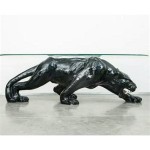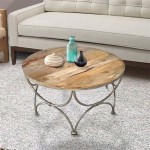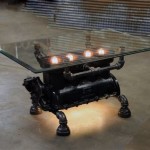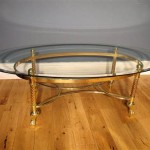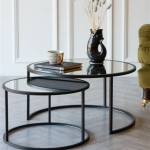How To Lighten a Dark Table: A Comprehensive Guide
Dark-colored tables, while often exuding an aura of sophistication and elegance, can sometimes present challenges in interior design. They may absorb light, making a room feel smaller and darker, or clash with brighter color schemes. Fortunately, there are several methods available to lighten a dark table, ranging from simple adjustments in lighting to more involved refinishing techniques. The most suitable approach depends on the type of table, the desired aesthetic, and the level of effort the individual is willing to invest.
Before embarking on any significant changes, it is crucial to assess the table's material and finish. Is it solid wood, veneer, laminate, or another material? Is it painted, stained, lacquered, or simply oiled? Understanding the composition and existing finish will dictate which methods are appropriate and prevent accidental damage. Each technique carries its own set of advantages and disadvantages, and some are better suited for specific materials or finishes than others.
Enhancing Ambient and Task Lighting
One of the most straightforward and least invasive ways to lighten a dark table is to improve the lighting in its immediate vicinity. Since dark surfaces absorb light, strategic lighting placement can compensate for this effect. This involves both augmenting the overall ambient light in the room and incorporating task lighting specifically focused on the table's surface.
Increasing ambient light can be achieved by adding brighter overhead fixtures, such as chandeliers, pendant lights, or recessed lighting. Selecting light bulbs with a higher lumen output will significantly brighten the room. Consider using light bulbs with a color temperature that complements the room's decor. Warmer tones can create a cozy atmosphere, while cooler tones can evoke a more modern and crisp feel.
Task lighting, on the other hand, provides focused illumination for specific activities. Lamps, both table lamps and floor lamps, are excellent options for directing light onto the table's surface. A well-placed table lamp can not only lighten the table but also create a visually appealing focal point. Floor lamps can be positioned to cast light from above, mimicking natural daylight and minimizing shadows. Adjustable lamps are particularly useful, as they allow for precise control over the direction and intensity of the light.
In addition to artificial lighting, maximizing natural light is equally important. Keeping windows clean and unobstructed will allow more sunlight to enter the room. Consider using sheer curtains or blinds that diffuse light without blocking it entirely. Positioning the table near a window can significantly enhance its brightness without requiring any permanent changes to the table itself.
Mirrors are another effective tool for amplifying light. Placing a mirror near the table can reflect light and create the illusion of a larger, brighter space. The mirror's placement should be strategic, ensuring that it reflects a light source rather than a dark corner. A large mirror can be particularly effective, but even smaller mirrors can make a noticeable difference.
Refinishing the Table: A More Permanent Solution
If lighting adjustments are insufficient, refinishing the table may be necessary to achieve the desired lightness. Refinishing involves stripping the existing finish and applying a new, lighter finish or paint. This process requires more time and effort but can dramatically transform the table's appearance. Before proceeding, it is essential to thoroughly research the appropriate techniques and materials for the specific type of table being refinished.
The first step in refinishing is to strip the existing finish. This can be done using chemical strippers, sanding, or a combination of both. Chemical strippers are effective for removing multiple layers of finish but require careful handling due to their potentially harmful fumes. Sanding is a more manual process but allows for greater control over the amount of material removed. When sanding, it is crucial to use progressively finer grits of sandpaper to achieve a smooth, even surface.
Once the old finish is removed, the table should be thoroughly cleaned and prepared for the new finish. Any imperfections, such as scratches or dents, should be filled with wood filler and sanded smooth. The surface should then be wiped down with a tack cloth to remove any remaining dust or debris.
The choice of new finish or paint will significantly impact the final appearance of the table. Lighter stains can enhance the natural grain of the wood while lightening its overall color. Paint offers a wider range of color options, allowing for complete transformation of the table's aesthetic. When selecting paint, consider the desired level of sheen. Matte finishes tend to absorb more light, while gloss finishes reflect more light. Semi-gloss or satin finishes are often a good compromise, providing a balance between light reflection and durability.
After applying the chosen finish or paint, it is important to allow it to dry completely according to the manufacturer's instructions. Multiple coats may be necessary to achieve the desired coverage and durability. Once the finish is dry, a protective topcoat can be applied to further enhance its durability and resistance to scratches and stains. Polyurethane is a popular choice for topcoats, as it provides a tough, clear finish that is easy to clean.
Refinishing veneer tables requires extra caution, as the veneer layer is often very thin. Aggressive sanding or stripping can easily damage the veneer, revealing the underlying substrate. When refinishing veneer, it is generally recommended to use chemical strippers sparingly and to sand very lightly, if at all. Alternatively, consider painting the table instead of staining it, as paint can conceal minor imperfections and provide a uniform surface.
Introducing Light-Reflecting Accessories and Décor
Beyond lighting and refinishing, incorporating light-reflecting accessories and décor can significantly lighten a dark table and its surrounding area. These elements can complement the table's existing color while adding brightness and visual interest to the room. The strategic use of accessories can create a cohesive and balanced aesthetic.
Table runners and placemats in light colors, such as white, cream, or pastel shades, can provide a stark contrast to the dark table surface, instantly making it appear brighter. Fabrics with a slight sheen, such as silk or satin, can further enhance light reflection. Consider using patterns with light-colored backgrounds to add visual interest without darkening the overall effect.
Centerpieces are another opportunity to introduce light and color. A vase filled with bright flowers, a bowl of fruit, or a collection of candles can draw the eye and create a focal point. Silver or glass candle holders will reflect light, adding a touch of elegance and brightness to the table. When choosing a centerpiece, consider its size and scale relative to the table. A centerpiece that is too large can overwhelm the table, while one that is too small may get lost.
Mirrored trays or coasters can reflect light and protect the table surface from scratches and stains. These small details can make a significant difference in the overall brightness of the table. Alternatively, consider using coasters made of light-colored stone or ceramic, which will also help to lighten the surface.
Wall art and accessories near the table can also contribute to its overall brightness. Hanging a light-colored painting or print on the wall behind the table can reflect light and create a sense of depth. Consider using frames with metallic accents, such as gold or silver, to further enhance light reflection. Avoid hanging dark or heavily saturated artwork in close proximity to the table, as this can counteract the efforts to lighten it.
Ultimately, lightening a dark table involves a multifaceted approach. Combining strategic lighting, appropriate refinishing techniques, and carefully selected accessories can transform the table's appearance and create a brighter, more inviting space. The specific methods chosen should be tailored to the table's material, finish, and the desired aesthetic.
Stripping A Table Method For Lightening Dark Wood Furniture Joyfully Treasured

How To Simply Lighten Stained Wood 3 Helpful Tools Open Doors Hearts

How To Simply Lighten Stained Wood 3 Helpful Tools Open Doors Hearts

How To Brighten A Dark Living Room The Easy Way

How To Lighten Wood Without Bleach Quick Furniture Flip

Strip Furniture Don T Paint This Gorgeous Solid Oak Drafting Table Thrift Diving

Refinishing Our Dark Wood Table

How Can I Lighten The Color Of This Dark Table Hometalk
Stripping A Table Method For Lightening Dark Wood Furniture Joyfully Treasured

How To Simply Lighten Stained Wood 3 Helpful Tools Open Doors Hearts
Related Posts



